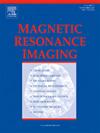用ct样成像评价下肢动脉疾病患者血管钙化和血管壁
IF 2
4区 医学
Q2 RADIOLOGY, NUCLEAR MEDICINE & MEDICAL IMAGING
引用次数: 0
摘要
目的下肢动脉疾病(LEAD)是外周动脉疾病(PAD)的主要表现之一,血管钙化对其预后有显著影响。本研究评估三维多回波T2*加权图像(T2*WI) ct样成像评估铅患者血管钙化及血管壁面积的可行性。材料与方法对20例铅铅患者(中位年龄75.0岁)采用s3.0 T MRI系统获取ct样图像。我们对10例之前接受过非对比CT的患者进行血管钙化评估,同时对另外10例使用三维(3D)脂肪抑制t1加权涡轮自旋回波(FS-T1 TSE)评估血管壁面积。结果CT样成像与非对比CT对血管钙化的视觉评价有中等程度的一致性(κ = 0.75),与钙化的定量评价有较强的相关性(r = 0.91-0.96)。Bland-Altman分析显示,ct样成像与FS-T1 TSE在血管壁面积测量上的偏差极小。结论ct样成像是评估铅患者血管钙化及血管壁面积的一种可行技术。无辐射暴露使其成为一种有希望替代CT进行血管评估的方法。本文章由计算机程序翻译,如有差异,请以英文原文为准。
Evaluation of vascular calcification and Vessel Wall in patients with lower extremity artery disease using CT-like imaging
Purpose
Lower extremity artery disease (LEAD), a major manifestation of peripheral arterial disease (PAD), is significantly influenced by vascular calcification, which impacts treatment outcomes. This study evaluates the feasibility of CT-like imaging using 3D multi-echo T2*-weighted image (T2*WI) for assessing vascular calcifications and vessel wall area in patients with LEAD.
Materials and methods
A 3.0 T MRI system was used to acquire CT-like images from 20 patients with LEAD (median age: 75.0 years). Vascular calcifications were assessed in 10 patients who had previously undergone non-contrast CT, while vessel wall area was evaluated in another 10 patients using three-dimensional (3D) fat-suppressed T1-weighted turbo spin-echo (FS-T1 TSE).
Results
CT-like imaging demonstrated moderate agreement with non-contrast CT for the visual assessment of vascular calcifications (κ = 0.75) and a strong correlation for the quantitative evaluation of calcification (r = 0.91–0.96). Bland–Altman analysis showed minimal bias in vessel wall area measurements between CT-like imaging and FS-T1 TSE.
Conclusion
CT-like imaging is a feasible technique for assessing vascular calcifications and vessel wall area in patients with LEAD. The absence of radiation exposure makes it a promising alternative to CT for vascular evaluation.
求助全文
通过发布文献求助,成功后即可免费获取论文全文。
去求助
来源期刊

Magnetic resonance imaging
医学-核医学
CiteScore
4.70
自引率
4.00%
发文量
194
审稿时长
83 days
期刊介绍:
Magnetic Resonance Imaging (MRI) is the first international multidisciplinary journal encompassing physical, life, and clinical science investigations as they relate to the development and use of magnetic resonance imaging. MRI is dedicated to both basic research, technological innovation and applications, providing a single forum for communication among radiologists, physicists, chemists, biochemists, biologists, engineers, internists, pathologists, physiologists, computer scientists, and mathematicians.
 求助内容:
求助内容: 应助结果提醒方式:
应助结果提醒方式:


